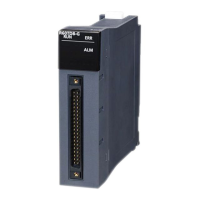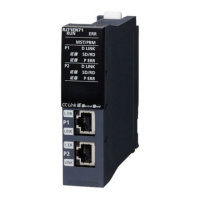APPX
Appendix 4 List of Special Relay Areas
829
A
Redundant function
The following is the list of special relay areas relating to the Redundant function.
No. Name Data stored Details Set by (setting timing) CPU
SM1630 Operation mode
identification flag
Off: Redundant system in
backup mode, stand-
alone system
On: Redundant system in
separate mode
This relay turns on while a redundant system
is operating in separate mode.
S (Every END) RnP
SM1632 System A identification
flag
Off: System B, system not
determined
On: System A
• This relay distinguishes between the
system A and the system B.
• The flag status does not change even if
tracking cables are disconnected.
S (Initial) RnP
RnPSF
SM1633 System B identification
flag
Off: System A, system not
determined
On: System B
• This relay distinguishes between the
system A and the system B.
• The flag status does not change even if
tracking cables are disconnected.
S (Initial) RnP
RnPSF
SM1634 Control system judgment
flag
Off: Standby system,
system not determined
On: Control system
• This relay indicates operating status of the
CPU module. The flag is stored in each
system when an initial processing is
performed (including when the system is
determined while waiting for the start-up of
the other system) and when a system
switching is completed.
• The flag status does not change even if
tracking cables are disconnected.
S (Initial/Status change) RnP
RnPSF
SM1635 Standby system
judgment flag
Off: Control system, system
not determined
On: Standby system
• This relay indicates operating status of the
CPU module. The flag is stored in each
system when an initial processing is
performed (including when the system is
determined while waiting for the start-up of
the other system) and when a system
switching is completed.
• The flag status does not change even if
tracking cables are disconnected.
S (Initial/Status change) RnP
RnPSF
SM1636 Previous control system
identification flag
When the previous control system is the
system B, this relay turns on during one scan
in the system A, following the RUN state after
both systems were powered on or the CPU
module is reset.
S (Every END) RnP
RnPSF
SM1637 System switching
detection (standby
system to control
system)
Off: Not detected
On: Detected
This relay turns on after the standby system
has been switched to the control system.
S (Status change) RnP
RnPSF
SM1643 ON for only one scan
after system switching
(standby system to
control system)
• This relay turns on during one scan after the
standby system was switched to the control
system.
• This relay can be executed only in a scan
execution type program.
S (Every END) RnP
RnPSF
SM1644 ON for only one scan
after system switching
(control system to
standby system)
• This relay turns on during one scan after the
control system was switched to the standby
system.
• This relay can be executed only in a scan
execution type program.
S (Every END) RnP
RnPSF
SM1645 System switching
request from a network
module
Off: System switching
request not issued
On
: System switching
request issued
• This relay turns on when a system
switching request from a network module is
issued.
• The module that issued system switching
can be checked in SD1645.
• This relay turns off when all bits of SD1645
are off.
S (Every END) RnP
RnPSF
SM1646 System switching by a
user
Off: Disabled
On: Enabled
• This relay stores whether to enable system
switching operation by a user using an
engineering tool or the SP.CONTSW
instruction.
• Initial value is off: System switching by a
user is prohibited.
URnP
RnPSF
ON
OFF
1 scan
ON
OFF
1 scan
ON
OFF
1 scan

